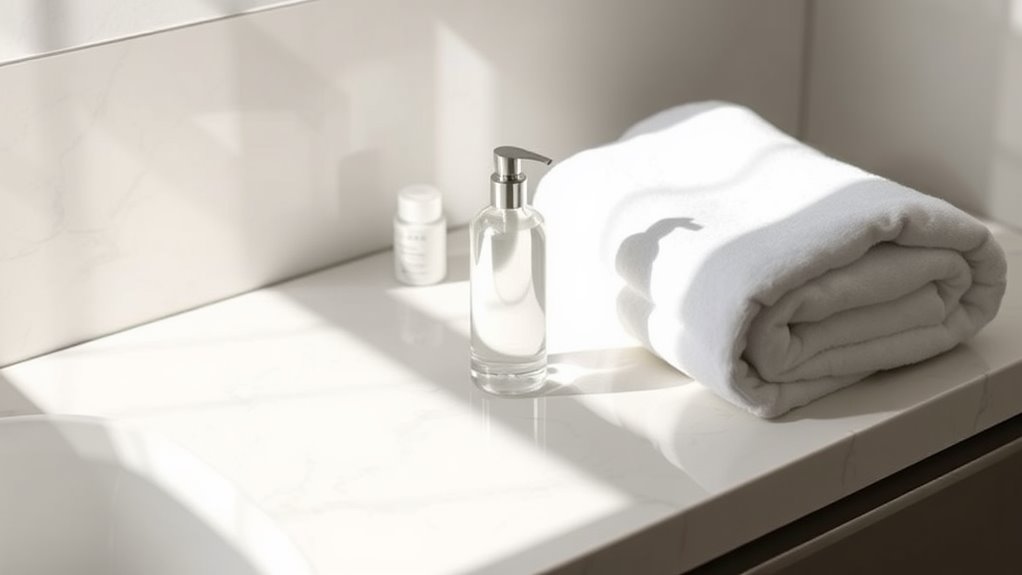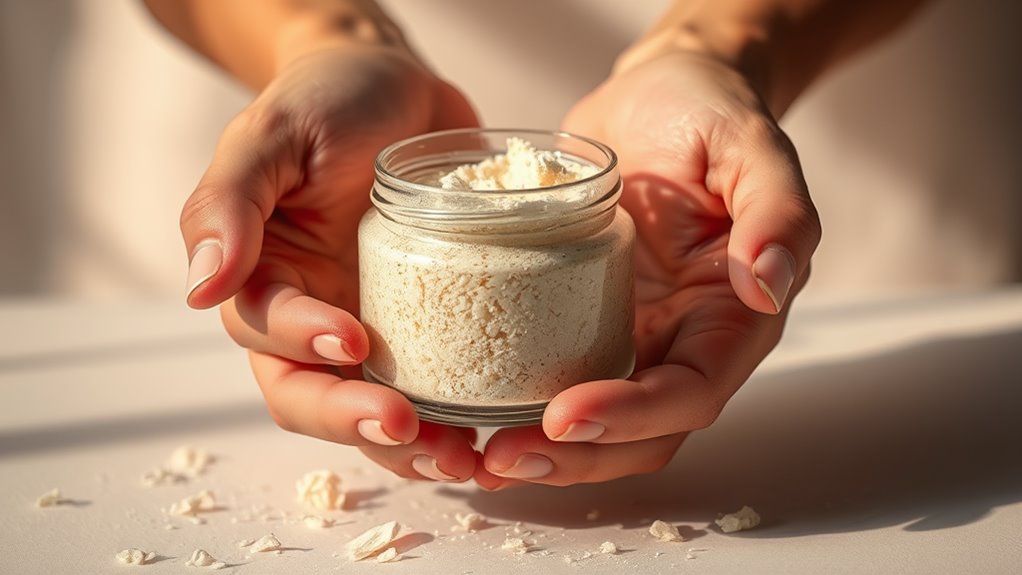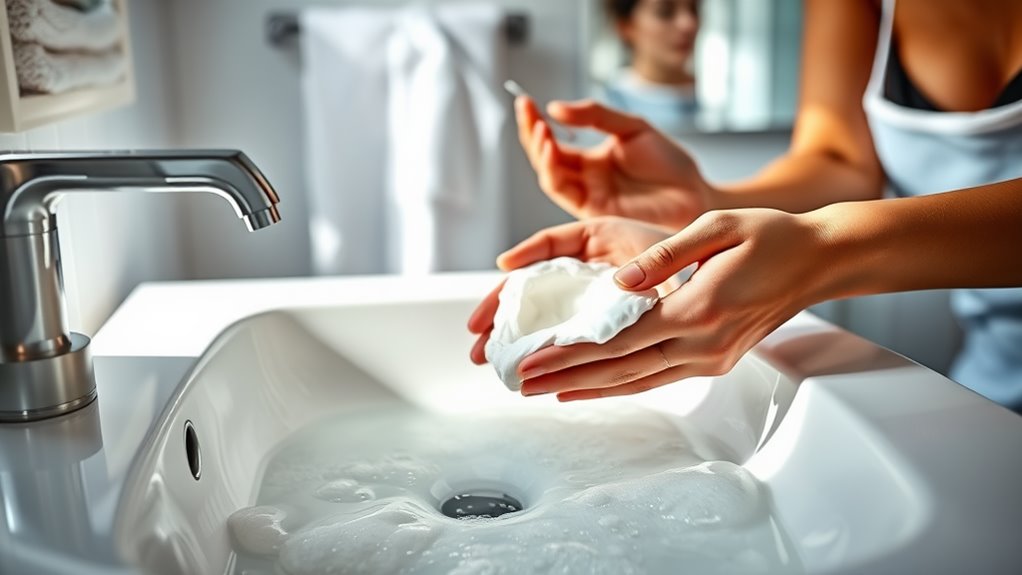What Happens When You Exfoliate Too Often. Let’s Break It Down
Exfoliating too often can lead to several negative effects on your skin. You might notice increased redness, irritation, and heightened sensitivity. Your skin could also become excessively dry and flaky, as over-exfoliation compromises your natural barrier. This can raise your risk for long-term issues like premature aging and chronic inflammation. To maintain a healthy complexion, it’s essential to find a balance. Discover effective tips for healthy exfoliation practices to protect your skin’s health.
Key Takeaways
- Over-exfoliation compromises the skin barrier, increasing its vulnerability to irritants and environmental damage.
- It strips away essential lipids and proteins, leading to excessive dryness and flakiness.
- Frequent exfoliation can cause increased skin sensitivity, redness, and a tight feeling.
- It disrupts natural oil production, potentially resulting in breakouts and chronic inflammation.
- Long-term effects include premature aging, fine lines, and increased susceptibility to skin conditions like rosacea.
Understanding Exfoliation
Exfoliation, while beneficial for your skin, requires a balanced approach to be effective.
It’s essential to understand that exfoliating removes dead skin cells, promoting cell turnover and enhancing your complexion. However, over-exfoliating skin can lead to adverse effects, including irritation, redness, and compromised skin barriers. In fact, excessive exfoliation can result in barrier damage, which makes your skin more susceptible to environmental stressors.
You should recognize the difference between physical exfoliants, like scrubs, and chemical ones, such as alpha and beta hydroxy acids. Tailoring your exfoliation routine to your skin type is crucial; for instance, sensitive skin may benefit from less frequent exfoliation.
Always listen to your skin and adjust your regimen accordingly. Mastering the right balance ensures you harness the benefits of exfoliation without risking damage.
Embrace a thoughtful approach for lasting results.
Signs of Over-Exfoliation
When you notice your skin becoming increasingly sensitive or red, it might be a sign that you’ve over-exfoliated. Other indicators include excessive dryness, flakiness, or a tight feeling that wasn’t there before.
You may also experience breakouts or a stinging sensation when applying products. If your skin looks dull or lacks its usual radiance, this could further suggest that you’ve stripped away too much of its natural barrier.
Additionally, an unusual increase in oiliness might signal that your skin is compensating for the loss of moisture. Pay attention to these signs; they indicate it’s time to reassess your exfoliation routine.
It’s essential to understand that over-exfoliating can disrupt your skin’s natural barrier function, leading to further irritation and damage. Prioritize healing your skin before continuing with aggressive exfoliation methods.
The Impact on Skin Barrier
Over-exfoliating can significantly compromise your skin barrier, which serves as the first line of defense against environmental aggressors and moisture loss.
When you exfoliate too frequently, you strip away essential lipids and proteins that maintain the barrier’s integrity. This disruption weakens your skin’s ability to retain moisture and protect against pollutants, leading to increased vulnerability.
As a result, your skin may become more susceptible to damage from UV rays and irritants. Additionally, a compromised barrier can hinder the effectiveness of other skincare products, as they may penetrate too deeply or not at all. The dangers of over-exfoliating can lead to irritation and sensitivity, further exacerbating the issue.
To preserve your skin’s health, focus on a balanced exfoliation routine that respects your skin’s natural protective functions. Mastering this balance is crucial for optimal skin health.
Irritation and Redness
Frequent exfoliation can lead to irritation and redness, which are signs that your skin is reacting negatively to the process.
When you exfoliate too often, you strip away the protective outer layer of your skin, leaving it vulnerable. This can result in inflammation, manifesting as red patches or a burning sensation. You may also notice increased dryness as your skin struggles to recover. According to dermatologists, daily exfoliation can also compromise your skin’s natural barrier, causing increased sensitivity and discomfort.
It’s crucial to listen to your skin; if you experience these symptoms, it’s a signal to reduce the frequency of exfoliation. Aim for a balanced routine that allows your skin to regenerate without constant disruption.
Increased Sensitivity
Increased Sensitivity
Exfoliating too often can lead to increased sensitivity in your skin, making it more reactive to products and environmental factors.
This heightened sensitivity can result in discomfort and frustration, detracting from your skincare goals. You might find that even the gentlest of products cause irritation, leading to a cycle of trial and error that feels endless.
- You may feel a burning sensation after applying your favorite moisturizer.
- Everyday pollutants could leave your skin feeling raw and exposed.
- The sun might seem harsher, causing you to avoid outdoor activities. Additionally, those with sensitive skin symptoms may notice these reactions more intensely, underscoring the need for careful product selection.
Breakouts and Acne
When you exfoliate too much, you might find that breakouts and acne become more frequent.
Over-exfoliation can strip your skin of its natural oils, disrupting your skin’s barrier. This imbalance can trigger an overproduction of sebum, leading to clogged pores and, ultimately, acne.
Additionally, excessive exfoliation can irritate your skin, making it more susceptible to inflammation and bacterial growth, which further exacerbates breakouts.
You may also experience a cycle of skin that feels oily yet dry, prompting you to exfoliate even more in an attempt to address the issues.
To maintain a clear complexion, limit exfoliation to 1-3 times a week, depending on your skin type, and pay attention to your skin’s response to the treatment.
Dryness and Flakiness
Excessive exfoliation can lead to noticeable dryness and flakiness, as it removes essential layers of skin that help retain moisture.
When your skin becomes too dry, it may not only feel uncomfortable but can also compromise its overall health. You might find yourself battling:
- Irritation that makes your skin appear red and sensitive
- Uneven texture that disrupts your skin’s natural glow
- Increased vulnerability to environmental stressors
These symptoms can significantly impact your confidence and self-image.
To maintain your skin’s integrity, it’s crucial to find a balance in your exfoliation routine. Aim for moderation, ensuring your skin remains hydrated and healthy.
Long-term Skin Damage
If you’re not careful with your exfoliation habits, you could be setting yourself up for long-term skin damage. Over-exfoliating can compromise your skin’s barrier, leading to increased sensitivity and susceptibility to environmental aggressors.
You may experience chronic redness and inflammation, which can exacerbate conditions like rosacea or eczema. Furthermore, excessive exfoliation can disrupt your skin’s natural oil production, resulting in an imbalance that contributes to premature aging.
Fine lines and wrinkles may appear sooner than expected, as your skin loses its ability to retain moisture and elasticity. To maintain healthy skin, it’s crucial to recognize that moderation is key; understanding your skin’s unique needs will help you avoid these detrimental effects.
Prioritize balance to ensure long-term skin health.
How to Find the Right Balance
Finding the right balance in exfoliation starts with understanding your skin type, as different types require different care.
You’ll want to consider how often to exfoliate based on your skin’s needs and sensitivities.
Additionally, selecting the right products can make a significant difference in achieving healthy, glowing skin without overdoing it.
Skin Type Considerations
Understanding your skin type is crucial for determining the right exfoliation frequency, as each type reacts differently to various products and methods.
For example, oily skin may tolerate more frequent exfoliation, while dry or sensitive skin might require a gentler approach. Identifying your skin type can help you avoid irritation and maintain balance.
- You’ll achieve a smoother, more radiant complexion.
- You can prevent breakouts and minimize enlarged pores.
- You’ll protect your skin’s natural barrier, ensuring long-term health.
Frequency Recommendations
Knowing your skin type sets the stage for determining how often you should exfoliate. Striking the right balance is crucial to avoid irritation while reaping the benefits. Here’s a quick reference guide to help you find your frequency:
| Skin Type | Recommended Frequency | Notes |
|---|---|---|
| Oily | 2-3 times per week | Focus on chemical exfoliants. |
| Dry | 1 time per week | Prioritize gentle exfoliation. |
| Combination | 1-2 times per week | Adjust based on specific areas. |
| Sensitive | Every 1-2 weeks | Use very mild exfoliants only. |
Product Selection Tips
Selecting the right exfoliating product is essential for maintaining skin health without causing irritation. You’ll want to choose an exfoliant that caters to your skin type, so pay attention to formulations and ingredients.
Here are some key tips to help you find that perfect balance:
-
Gentle is key: Opt for products with mild exfoliating agents, especially if you have sensitive skin.
-
Check pH levels: Look for a balanced pH to ensure your skin barrier remains intact.
-
Hydration matters: Pair exfoliants with hydrating ingredients to minimize dryness.
Tips for Healthy Exfoliation Practices
Although exfoliation can significantly improve your skin’s texture and appearance, it’s essential to practice it wisely to avoid irritation or damage.
First, choose the right exfoliant based on your skin type; gentle chemical exfoliants often suit most skin types better than harsh physical scrubs. Limit exfoliation to once or twice a week, allowing your skin time to recover.
Always follow up with a hydrating moisturizer to replenish moisture. Incorporate sunscreen daily, as exfoliation can increase sensitivity to UV rays.
Pay attention to your skin’s response; if you notice redness or irritation, reduce frequency or switch products. Lastly, consult a dermatologist for personalized advice tailored to your specific skin needs.
Mastering these practices will enhance your skin health effectively.




